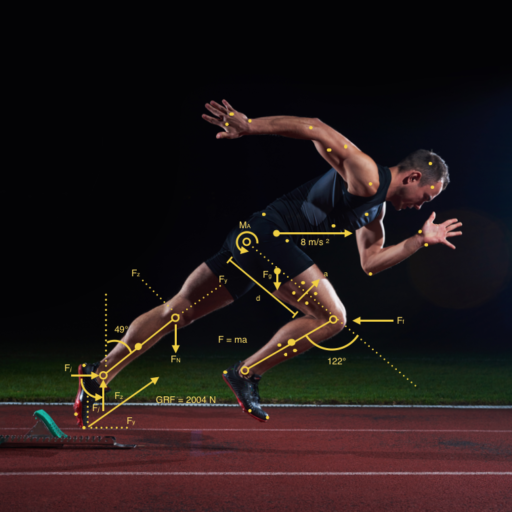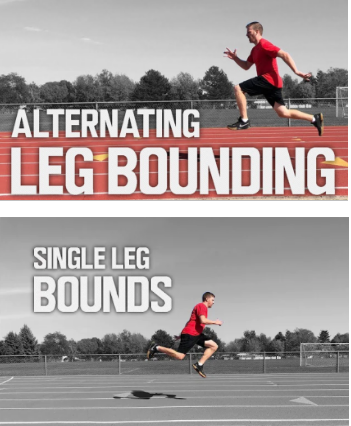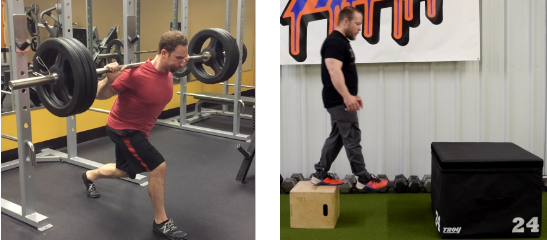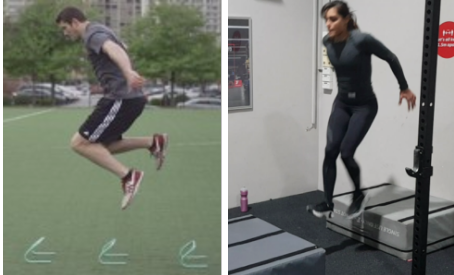
To reiterate what was covered in Part 1 & Part 2, the ultimate goal in sprinting is:
To apply as much vertical force down into the ground as possible, in as brief a ground contact time as possible, while staying as stiff as possible all the way up the kinetic chain.
.
STRIDE LENGTH (SL)
All the recent research suggests that SL is the differentiating factor b/w elite and sub elite athletes (SF are often similar in these two groups even though max velocities and performance times are significantly better in the elite cohort (clark & Weyland 2014)). Also a well referenced study in the 1990’s stated “85% of running velocity variance is explained by variance in Stride Length (not Stride Rate)”. Delecluse et al 1995.
If we take this to be true, then as sprint coaches, we need to do all we can to maximise the athlete’s capacity to increase their SL and this comes back to the development of the most appropriate limb kinematics (leg positioning under the COG to minimise breaking impulses – not having the athlete reach out as is often the goal by many beginner sprint coaches) and apply the greatest force possible into the ground (kinetics) in the shortest time to a) overcome gravity and b) continue to propel the body across the ground.
The challenge here is we are trying to improve the athlete’s capacity to generate high IMPULSE during a short ground contact.
IMPULSE = Force x Time.
This equation means that there are two ways of increasing your IMPULSE, you can increase force or increase the time you apply the force.
During starts and early acceleration, you have the time to apply force (Time) but as you start to reach maximum velocity, you now just don’t have the time to apply the force required so therefore you must try apply as much force as possible in less time (typically <100ms). This requires very specialised strength and power training routines to achieve this force-time capacity.
As outlined in one of my earlier articles (Maturation and sprinting), the young and not strong sprint athlete will try to increase the time on the ground to make up for the lack of force. This unfortunately results in them leaving their foot on the ground for too long resulting in rear sided sprint mechanics (and all the associated dangers with this technical model).
The entire conditioning program for sprinters should be based on developing the attributes that achieve these above goals.
PLYOMETRICS
I completed a post graduate thesis in the 1990’s (Sprinting kinematics between sprinting and plyometrics) and the study in question looked at several plyometric exercises, Countermovement jump (Slow stretch shorten cycle), high speed alternate leg bounds and high speed single leg hopping (Fast stretch shorten cycle) and compared these characteristics to maximal velocity kinematics (subjects included almost all the best 100m sprinters in the country at the time).
The outcome of the study showed that there was a strong correlation b/w high speed alternate leg bounding ground contact times and elite sprint performance (particularly the acceleration phase) and a weak correlation b/w High speed single leg hops and elite performance (more to do with the lack of the elite sprinters in the group who undertook this form of plyometric exercise).

What was of interest and largely confused the issue was that the current best sprinter of the group didn’t do any plyometrics at all, whilst the second best sprinter was the best bounder I had ever seen (indicated by an average hop length of >4.00m during his Single Leg Bounds!!). It wasn’t in the scope of the study to look at these individual variances but would have been very interesting to evaluate the strengths of these sprinters and how they ended up with similar outcomes from very different paths. Many roads lead to Rome!!!
What was clear from the study was that even those International class sprinters who didn’t do a lot of plyometics were still really good at plyometrics!!! It was more of a coordination issue with them during the testing than actual power output.
If we analyse High Speed Single Leg Hops, the kinematics of each limb is quite similar to that in sprinting (high knee position and rapid hip extension into the ground with resulting vertical GRF). Whilst often with ALB (particularly when the emphasis is on distance alone) you will see athletes get long with their stride resulting in more horizontal force production, less vertical GRF and increased horizontal breaking forces (suggesting that ALB’s are better for the acceleration component of the sprint where as the Single Leg ALB is more a top speed plyometric).
.
One way of determining which plyometric exercises you should incorporate into your routines can be through better understanding GCT’s during different phases of the sprint performance.
SPRINTING GCT
Sprinting Phase
- Block Starts
- Acceleration
- Top Speed
GCT
- 250ms-300ms
- 170ms-120ms
- <100ms
If we look at the kinematics of the typical plyometric exercises we see used, we can start to get a clearer picture as to what is suitable for which part of the race and time of the year.
PLYOMETRIC GCT
- Squat Jumps
- CMJ
- Depth Jump variations
- Stiff Ankle bounds
- ~30cm Box Jump to 30cm Box rebound
- 400ms
- 350ms
- 200ms-300ms
- 130ms-170ms
- 130ms-150ms
*A progression can be from a 2-foot landing/take off to 1 foot landing/take off.
Many of the plyometrics we have our athletes undertake are not very sprint specific (in terms of GCT) but do improve the athlete’s tolerance to increased GRF and thereby strengthen the entire musculoskeletal system to the load demands in sprinting. As an example, I added “shock jumps” to one of my elite athlete’s program many years ago, this included stepping off varied height boxes (up to 120cm) and landing on the ground with minimal collapse (and no rebound) – the GRF’s through the body were very high and this exercise improved this athlete’s ability to tolerate the GRF’s experienced during his sprinting/hurdling performances.
Plyometrics increases muscle stiffness (less compliance) resulting in a greater force being generated through the tendon (greater stretch, faster recoil). Plyometric training also reduced neural inhibition at ground contact. Hirayama et al 2017. Whilst heavy strength training increases tendon stiffness allowing more of the tension to be placed upon the tendon with its high force generation capacity.
It makes sense to periodize these two key training modalities (strength and plyometrics) in a way that they complement each other. There has been numerous papers over the past 30-years showing the benefits of combining strength with plyometric type activities in a gym setting.
An example strength/plyometrics routine we are going to experiment with in the off-season consists of the following combination:
Heavy small range Bulgarian split squat (10-15o) – 3-5 reps/leg – immediately followed by 30cm single leg drop jumps with immediate hop back up to another 30+cm box (with the goal of the ground contact times being ~100ms and the largest height rebound possible).

The small range Bulgarian Split squats assists with the hip and knee joint stiffness whilst the single leg box drop jump-rebounds assists with ankle stiffness. Any collapse throughout the foot-ankle complex will prolong ground contact time, decrease stiffness, and generally not provide the desired training benefit.
This routine deals with the two key aspects of sprint kinetics that is key for high level performance:
a. The body has to remain stiff in the two main anatomical planes:
Sagittal Plane – ankle and knee
Frontal Plane – hip/pelvis
Too much compliance in these planes leads to decreased force production and increased GCT (neither are optimal).
b. High force generation in short contact times – single leg drop jumps with rebound are a great way of training this physical modality (it is important to have a rebound as athletes may try to decrease their ground contact by applying less force and just pulling the foot off the ground – by requiring an effort to jump up onto another height you remove this potential technical fault).

1 leg vs 2 leg Plyometrics
There has also been a lot of research on the value of single versus double leg plyometrics for power generation and elite performance See recent paper – Bogdanis et al 2019.
This paper stated that unilateral lower limb plyometric training was effective at improving both single and double-leg explosive performance, while an equal volume of bilateral training only improved bilateral performance (and as sprinting is a unilateral movement it is clear that single leg plyometrics are key to maximising overall sprint performance).
If we think about the athlete’s entire musculoskeletal system when programming these sorts of exercises it makes sense to be as movement specific as possible as there are increased loads placed upon in particular the hip/pelvis region when an athlete is required to complete single leg jumping exercises compared to much more stable double leg varieties.
Immediately there is a larger emphasis on frontal plane stabilisation with single leg plyometrics (including key muscles such as gluteus medius, quadratus lumborum and adductors).
If there isn’t the concomitant increase in frontal plane stabilisation strength with any increase in overall plyometrics strength, then much of this “power” improvement will not be accessible due to poor force transmission at ground contact (through pelvic collapse and power leakage throughout each ground contact).

So where possible try to incorporate single leg plyometric jumping activities as this is more movement specific as well as better for total body stability and coordination development.
If you take this approach then you do need to be careful as the loads being placed unilaterally are very high – taking a conservative approach to both intensity of impacts and volumes are key to ensure that the athlete adapts with minimal over-training.
Some example exercises that can start to prepare your athletes for more advanced plyometric routines include:
- Single leg pogos in warmup
- Mini hurdle single leg hops
- Skipping
- Forward/lateral/backward hopping
- Mini box jumps (on and off).
- Dynamic step Ups

All the above exercises allow the musculoskeletal system (particularly in the ankle) to begin to adapt and tolerate the repeated impacts. With many of these exercises I will have the athlete forcefully drive their feet into the ground (with a focus on good technique – dorsiflexed ankle, flat foot) with as much focus on musculoskeletal tolerance over time as improvement in plyometric ability.
Whilst it is an old story, I remember once reading that Pietro Mennea (former 200m world record holder and Olympic 200m champion) would perform all his plyometrics with a focus on trying to keep his GCT below 100ms. If anyone has been lucky enough to see this man run live, it was a beautiful thing – he seemed to just float across the track….
.
PRACTICAL EXAMPLES:
Sprinting light footed!!
One thing I have noticed with certain athletes is an ineffective force application when running across the ground. The athlete may look light across the ground and technically proficient but aren’t actually running fast – If you could easily measure the kinetic variables of these athletes (in particular their GRF) I would guess that they are not hitting the ground very hard and are just floating across the ground without applying the levels of GRF that are required to run truly fast….
I worked with such an athlete, looked beautiful when running but did not generate the maximum velocities that would be expected based on her physical appearance during sprinting.
It is these athletes that I believe a targeted high strength/plyometric routine can be of huge benefit. They already have the basic mechanics, you just need to increase their engine capacity (strength/power) to have them begin to reach their maximum velocity capacity.
.
Strong versus wiry Athlete
We are all familiar with the different builds of our sprint athletes, some are very strong/muscular whilst others struggle to gain any muscle mass but are still very fast.
A good question to ask is: Which athlete type benefits from weights versus plyometrics/speed type training?
As a general guide I would try to increase a strength athlete’s plyometric ability whilst working on increasing the raw strength of the more wiry type athlete.
What can happen with strong athletes is that they have often gotten strong through the use of weight training and typically strength training is slow – which is required muscle physiology to generate maximum force when lifting.
If you look at this typical Force-Time curve, you see that strong athletes (green) need time to generate the high levels of strength that they possess – this is problematic for the sprint athlete as you only have this time in the first 1-2 steps and then rate of force development becomes more important.
The high rate of force development athlete can lack the absolute force required so this is why it is important to determine which type of athlete you are working with as this will then dictate the sort of training to have them undertake during preparation phase training.

Sprinters with Hamstring Issues
There are a small number of sprinters who suffer from regular hamstring issues with sprinting. I have previously addressed this issue as often being related to poor sprint mechanics but also this can be an issue with force generation during the sprint cycle and improper conditioning routines to prepare the athlete’s musculoskeletal system for these loads.
As an example, there is a view that some hamstring tears are preceded by a high force co-contraction at ground contact phase resulting in the hamstring then straining whilst completing the swing phase of the stride cycle.
This high level of co-contraction and rapid braking of a high hip extension velocity creates very high stress levels throughout the hamstring muscle group causing potential microtear and neural overloading which is then presented as a strain in the subsequent swing phase.
This can definitely be exacerbated by poor sprint mechanics, as an example landing too far forward of your COG at ground contact will create horizontal breaking forces and will also require the athlete to have to overcome these breaking forces by increasing force production by largely the hamstring muscle group to overcome the incorrect ground placement. It is just a matter of time for the hamstring muscle complex to fail under these conditions. Another reason why the focus on developing the best sprint mechanics as possible with your athletes is a key goal to both sprinter health and ultimate performance.
Hopefully these papers have given you something to think about as you go about preparing your athlete for the upcoming season and I wish you all the best with your coaching.
Adrian Faccioni
REFERENCES
1. Plyometric Training Favors Optimizing Muscle–Tendon Behavior during Depth Jumping.
Kuniaki Hirayama, Soichiro Iwanuma, Naoki Ikeda, Ayumi Yoshikawa, Ryoichi Ema, Yasuo Kawakami. Front. Physiol., 25 January 2017
2. Comparison Between Unilateral and Bilateral Plyometric Training on Single- and Double-Leg Jumping Performance and Strength. Bogdanis, Gregory C.1; Tsoukos, Athanasios1; Kaloheri, Olga1; Terzis, Gerasimos1; Veligekas, Panagiotis1; Brown, Lee E.2 Journal of Strength and Conditioning Research: March 2019 – Volume 33 – Issue 3 – p 633-640
3. Kinematics of Maximal Speed Sprinting With Different Running Speed, Leg Length, and Step Characteristics. Kenji Miyashiro, Ryu Nagahara, Kohei Yamamoto and Takahiko Nishijima. Front Sports Act Living. 2019; 1: 37.
4. Post Activation Potentiation of sprint performance using ALB + 10%.
Turner, AP, Bellhouse, S, Kilduff, LP & Russell, M 2015, ‘Postactivation potentiation of sprint acceleration performance using plyometric exercise’, Journal of Strength and Conditioning Research, vol. 29, no. 2, pp. 343–350
5. Sprint Kinetics, Kinematics, and Training Application with Ken Clark.
https://simplifaster.com/articles/sprint-kinetics-kinematics-ken-clark/


